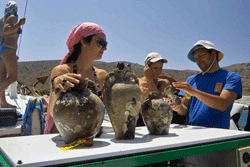First Minoan shipwreck
- On 21/02/2010
- In Underwater Archeology
- 0 comments

By Eti Bonn-Muller - Archaeology
An unprecedented find off the coast of Crete.
Crete has seduced archaeologists for more than a century, luring them to its rocky shores with fantastic tales of legendary kings, cunning deities, and mythical creatures.
The largest of the Greek islands, Crete was the land of the Minoans (3100-1050 B.C.), a Bronze Age civilization named after its first ruler, King Minos, the "master of the seas" who is said to have rid the waters of pirates.
According to Thucydides, he also established the first thalassocracy, or maritime empire. The Minoans were renowned for their seafaring prowess, which opened trade routes with the powerful kingdoms of Egypt, Anatolia, and the Levant.
Depictions of ships abound on Minoan seals and frescoes. They are detailed enough to show that the vessels were impressive: generally, they had 15 oars on each side and square sails, and were probably about 50 feet long.
But little more was known about actual Minoan seafaring--until Greek archaeologist Elpida Hadjidaki became the first to discover a Minoan shipwreck.
Hadjidaki, a self-described "harbor girl," was born and grew up in the Cretan seaside town of Chania. An experienced and passionate diver trained in classical archaeology, she received funding from the Institute for Aegean Prehistory in 2003 to search for early ships near Crete.
"I always wanted to find a Minoan shipwreck," she says, "so I started looking for one."
For nearly a month, she and a team of three sponge and coral divers aboard a 20-foot-long wooden fishing boat trolled up and down the island's shores.
Together with George Athanasakis of Athens Polytechnic University, they used side-scanning sonar and detected some 20 "targets," or anomalies, that Hadjidaki sent her divers to investigate, often reaching depths of 400 feet.
One by one, they turned out to be a depressing array of natural geological formations and portions of the seafloor ripped up by the nets of deep-sea trawlers, as well as a World War II airplane, a 19th-century shipwreck, and several pairs of shoes.
Greece shipwreck ancient civilisation
Add a comment